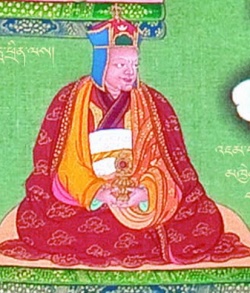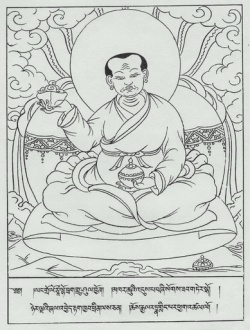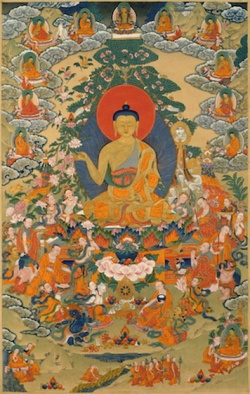Ratna Lingpa
By Jakob Leschly
Ratna Lingpa (rat+na gling pa) was born in 1403 into a wealthy family in Drushul, Lhodrak (lho brak gru shul). His father was Dode Dar (mdo sde dar) and his mother was Sitar Men (sri thar sman). He was said to have been an incarnation of Langdro Konchok Jungne (lang gro dkon mchog 'byung gnas), one of the twenty-five disciples of Padmasambhava. A child prodigy, Ratna Lingpa learned reading and writing effortlessly and had numerous pure visions, starting from the age of ten.
According to tradition, when Ratna Lingpa was twenty-seven, he experienced a vision of Padmasambhava in the form of a yogi dressed in yellow raw silk. He showed him three scrolls, a white, a red and a blue one, and asked Ratna Lingpa to choose one of them. Ratna Lingpa answered that he wanted all three. Because of the auspicious connection created by his answer, Ratna Lingpa received all three inventories, and was able to reveal in a single lifetime the termas he would have otherwise revealed in three successive lifetimes. He is therefore also known as Zhikpo Lingpa (zhig po gling pa) and Drodul Lingpa ('gro 'dul gling pa).
Starting at the age of thirty he revealed treasure across southern Tibet, at Khyungchen Drak (khyung chen brag), Dritang Koro Drak ('bri than ko ro brag), and Kharchu Pelgi Puk (mkhar chu dpal gyi phug), a total of twenty-five separate revelations on diverse topics such as peaceful and wrathful guru, Dzogchen, and Mahāmudrā. Among the cycles that continue to be practiced are the long-life cycle of the Tsedrub Sangdu (tshe sgrub gsang 'dus) and the Purba Yangsang Lame (phur pa yang gsang bla med).
In response to Buton Rinchen Drub's (bu ston rin chen grub, 1290-1364) exclusion of major Nyingma tantras from his influential Kangur (bka' 'gyur), Ratna Lingpa gathered together the tantic heritage of the Nyingma tradition, a work said to comprise forty-two volumes. It is said that this collection, no longer extant, was the basis for the Nyingma Gyubum that Jigme Lingpa ('jigs med gling pa, 1730-1798) assembled in the 1770s.
Ratna Lingpa's lineage was continued by his own children, especially his son Rigdzin Tsewang Drakpa (rig 'dzin tshe dbang grags pa, d.u.), and students such as Khardrung Sonam Tashi (mkhar drung bsod nams bkra shis, d.u.), the Second Drukchen Kunga Peljor ('brug chen 02 kun dga' dpal 'byor, 1428-1476) and the Sixth Karmapa, Tongwa Dondan (karma pa 06 mthong ba don ldan, 1416-1453).
In the early fifteenth century, Ratna Lingpa (Ratna gling-pa) compiled the Nyingma Gyubum (rNying-ma rgyud-'bum, Lakhs of Nyingma Tantras), the collection of all dzogchen texts and all the Old Transmission translations of tantras, expanding on Longchenpa's work.
Terton Ratna Lingpa Langdro Lotsawa returned to Trushul in Lhodrak,
You revealed the profound treasury of the four Kharchu Communions
Amongst your twenty‐five treasures, your activity touching us all:
Homage to Chogyel Ratna Lingpa.
Ratna Lingpa 1403‐1478/79. A reincarnation of Könchok Jungney of Langdro, he was born August 2nd 1403 to Dode Tar and his mother Sitar Men. At a very young age this great emanated master began having visions of Guru Pedma Jungnay and at the age of 27 received his first inventory cache directly from the great Guru himself. By 30 he extracted his first treasure cache and went on to discover 25 cycles of hidden treasures. Of the many writings attributed to Terton Ratna Lingpa, the most well‐known is the Nyingma Gyüdbum ‐ A collection of scriptures belonging to the Three Inner Tantras, gathered by Ratna Lingpa and re‐edited by Jigme Lingpa. Others include Dzepa Chuchig ‐ The Eleven Deeds of Padmasambhava, and Sangye Lakchang ‐ Placing Enlightenment in the Palm of the Hand. Within Palyul, Terton Ratna Lingpa’s most practiced terma is that of Phurpa Yangsang Lame ‐ The Most Secret and Unsurpassable Dagger. This is more commonly known as Ratna Lingpa Phurba (Vajrakilaya). Others include: Tukdrub Yangdü; Tukdrub Yangnying Dupa; Tsasum Drebu Dontri ‐ Essential Instructions for the Accomplishment of the Three Roots; Yidam Tsasum Drildrub; Tsedrub Sangwa Dupa, and others.
Sources
Bradburn, Leslie, ed. 1995. Masters of the Nyingma Lineage. Cazadero: Dharma Publications, 1995, pp. 197-199.
Dudjom Rinpoche. 2002. The Nyingma School of Tibetan Buddhism. Gyurme Dorje and Matthew Kapstein, trans. Boston: Wisdom.
Grags pa 'byung gnas. 1992. Gangs can mkhas grub rim byon ming mdzod. Lanzhou: Kan su'u mi rigs dpe skrun khang, pp. 717-718.
Gu ru bkra shis. 1990. Gu bkra'i chos 'byung. Beijing: Krung go'i bod kyi shes rig dpe skrun khang, pp. 450-457.
'Jam mgon kong sprul blo gros mtha' yas. 1976. Gter ston brgya rtsa. In Rin chen gter mdzod chen mo v.1 pp. 291-759. Paro: Ngodrup and Sherab Drimay, pp. 571-574.
Nyoshul Khenpo. 2005. A Marvelous Garland of Rare Gems. Richard Barron, trans. Junction City, California: Padma Publication.
Rat+na gling pa. 1984. Rat+na gling pa'i rnam thar skor. Bylakuppe: Pema norbu rinpoche.


